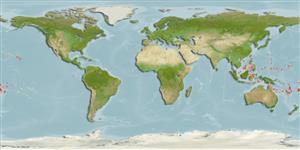>
Ovalentaria/misc (Various families in series Ovalentaria) >
Pomacentridae (Damselfishes) > Pomacentrinae
Etymology: Pomacentrus: Greek, poma, -atos = cover, operculum + Greek, kentron = sting (Ref. 45335); spilotoceps: Name from the Greek 'spilotos' for spotted and 'ceps' as short for head, referring to the orange or yellow spots on the head, its most characteristic markings.
More on author: Randall.
Environment: milieu / climate zone / depth range / distribution range
Ekologi
marina revassocierade; djupintervall 0 - 5 m (Ref. 86942). Tropical
Utbredning
Länder | FAO områden | Ekosystem | Förekomster | Point map | Utplanteringar | Faunafri
South Pacific: Fiji and Tonga.
Size / Vikt / Age
Maturity: Lm ? range ? - ? cm
Max length : 7.8 cm SL hane/ej könsbestämd; (Ref. 54980)
Short description
Bestämningsnycklar | Morfologi | Morfometri
Taggstrålar i ryggfenan (totalt) : 8; Mjukstrålar i ryggfenan (totalt) : 14 - 15; Taggstrålar i analfenan: 2; Mjukstrålar i analfenan: 15; Ryggkotor: 26. This species is distinguished by the following characters: D XIII,14-15 (usually 15); A II,15; pectoral rays 18; tubed lateral line scales 17-18 (usually 18); total gill rakers 22-24; sub-orbital naked and the margin serrate; posterior edge of pre-orbital with a strong retrorse spine; body depth 1.95-2.1 in SL; longest dorsal spine 1.55-1.65 in HL; second anal spine 1.4-1.5 in HL. Colouration: yellowish brown, scale edges blackish; dull yellow to pale orange spots on opercle and anterior to and above pectoral fin base; two blue lines on side of snout crossing the upper lip; a small vertically elongate deep blue or black spot at the upper end of gill opening, a small black spot at upper pectoral fin base; in adults the ocellus posteriorly in lower half of dorsal fin may be present or absent; caudal fin abruptly yellowish (Ref. 124650).
Occurs on shallow coral reegs in calm areas (Ref. 124650). Diurnal species (Ref. 52881). Oviparous, distinct pairing during breeding (Ref. 205). Eggs are demersal and adhere to the substrate (Ref. 205). Males guard and aerate the eggs (Ref. 205).
Life cycle and mating behavior
Könsmognad | Reproduktion | Lek | Ägg | Fecundity | Larver
Oviparous, distinct pairing during breeding (Ref. 205). Eggs are demersal and adhere to the substrate (Ref. 205). Males guard and aerate the eggs (Ref. 205).
Randall, J.E., 2002. Two new damselfishes of the genus Pomacentrus from the south-west Pacific. aqua, J. Ichthyol. and Aquat. Biol. 5(4):167-176. (Ref. 124650)
IUCN Red List Status (Ref. 130435: Version 2024-1)
Threat to humans
Harmless
Human uses
Verktyg
Special reports
Download XML
Internet-källor
Estimates based on models
Preferred temperature (Ref.
123201): 25.1 - 29.4, mean 28.4 °C (based on 1179 cells).
Phylogenetic diversity index (Ref.
82804): PD
50 = 0.5000 [Uniqueness, from 0.5 = low to 2.0 = high].
Bayesian length-weight: a=0.02455 (0.01155 - 0.05216), b=2.98 (2.81 - 3.15), in cm total length, based on LWR estimates for this Genus-body shape (Ref.
93245).
Trofisk nivå (Ref.
69278): 2.7 ±0.3 se; based on size and trophs of closest relatives
Resiliens (Ref.
120179): Hög, lägsta populationsfördubblingstid mindre än 15 månader (Preliminary K or Fecundity.).
Fishing Vulnerability (Ref.
59153): Low vulnerability (10 of 100).
Nutrients (Ref.
124155): Calcium = 428 [151, 957] mg/100g; Iron = 1.08 [0.54, 2.44] mg/100g; Protein = 17.4 [15.8, 18.8] %; Omega3 = 0.127 [0.050, 0.296] g/100g; Selenium = 9.29 [3.14, 25.41] μg/100g; VitaminA = 480 [88, 2,512] μg/100g; Zinc = 4.35 [2.39, 7.67] mg/100g (wet weight);
